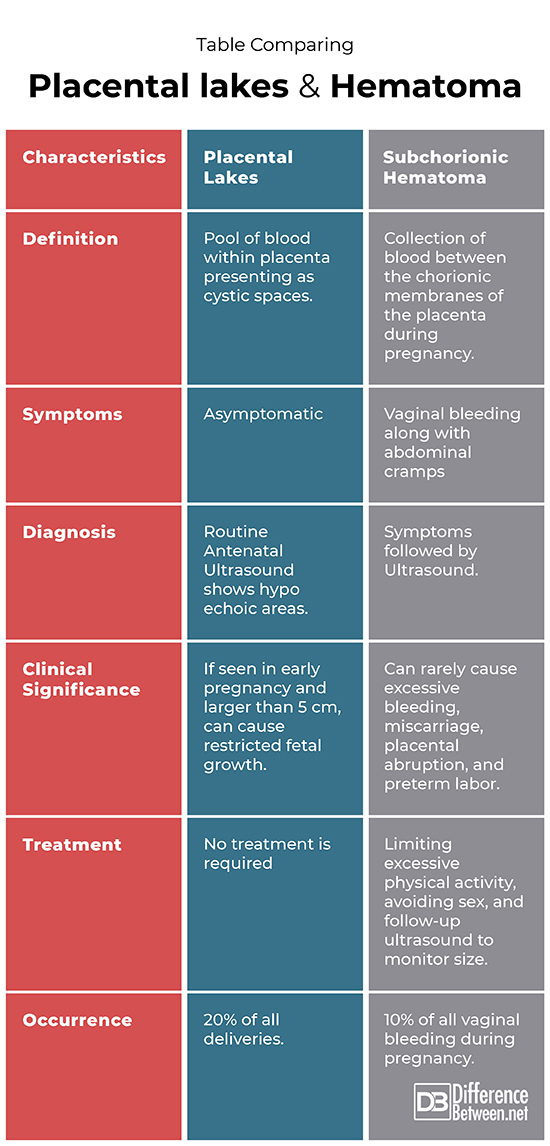Difference Between Placental Lakes and Hematoma
Placental lakes are pools of blood that either lie on the surface of the placenta or deeper inside and show up on the scan as blackened areas. Placental Hematoma is a collection of blood under the chorionic layer of placenta. A chorionic membrane is the layer that acts as attachment point between the amniotic sac and the wall of uterus.

What is a Placental Lake?
Definition
Placental Lakes are defined as pools of blood that can be found as cystic spaces during antenatal scans on the surface of the placenta or in the surrounding areas, they appear as hyper echoic spaces on the ultrasound scans. They are also called placental (venous) lakes.
Symptoms
Placental lakes show no clinical symptoms and are incidentally found by radiologists during routine antenatal scans.
Epidemiology
They occur in about 20 percent of all healthy pregnancies around the world.
Diagnosis
An ultrasound during the antenatal checkup can show well-defined hyper echoic areas within the placenta.
Clinical Significance
Placental lakes are of no clinical significance if they are found in the third trimester of pregnancy. However, if found during early pregnancy and the size is larger than 5 cm, they can be associated with the low gestational weight of the fetus and slow growth inside the uterus.
They can also be associated with an increase in the thickness of the placenta and abnormal adherence of the villus on the placenta.
Treatment
There is no significant treatment of placental lakes. They usually resolve on their own and have no significant effect on the outcome of pregnancy.
Your gynecologist/obstetrician will keep monitoring the lakes more than 5 cm in diameter if they affect fetal well-being and growth according to the gestational age.
Prognosis
The pregnancy outcome is good despite of the presence and absence of placental lakes.

What is a Hematoma?
Definition
A placental hematoma is formed during pregnancy when a pool of blood is collected inside the chorionic membrane of the placenta. It is also known as a sub chorionic hematoma.
Symptoms
Vaginal bleeding is the most common symptom of sub chorionic hematoma. It can either cause light spotting or heavy bleeding with clots. Sometimes stomach cramps are also accompanied with bleeding.
It can also be asymptomatic.
Diagnosis
Sub chorionic hematoma is diagnosed during the routine antenatal ultrasound.
Clinical Significance
Usually subchorionic hematoma doesn’t cause any significant risk to the pregnancy and resolves on its own. However, rare complications can result in preterm labor, miscarriage, excessive vaginal bleeding, or placental abruption.
Treatment
Many subchorionic hematomas are self-limiting and heal on their own time like routine wound healing. However, in some cases, the following treatments are suggested by the doctors
- Strict bed rest,
- limiting physical activity
- Regular monitoring of the size of the hematoma through ultrasound
- For Patients who are RhD negative, an anti-D immunoglobulin shot should be administered
- Avoid having sexual intercourse
- Hospital admission
Prognosis
Very small hematomas usually don’t impact the health of the baby or mother; however, care should be taken to prevent preterm labor, excessive bleeding, placental abruption or miscarriage.
Difference between Placental Lake and Hematoma
Definition
Placental lakes are the cystic spaces in the placenta containing a pool of blood while placental hematoma is when blood is collected between the chorionic membranes of the placenta.
Symptoms
Placental lakes are asymptomatic and usually cause no complications while vaginal bleeding with cramps is the common symptom of subchorionic hematoma.
Diagnosis
Placental lakes are diagnosed during routine antenatal ultrasound while subchorionic hematoma is diagnosed by clinical symptoms and later confirmed by ultrasound.
Clinical significance
Placental lakes if more than 5 cm in diameter can cause restriction in fetal well-being and growth. If the subchorionic hematoma is larger in size, it can cause excessive vaginal bleeding, preterm labor, placental abruption, and miscarriage.
Treatment
Placental lakes don’t require treatment and resolve on their own while placental hematoma requires strict bed rest, limiting physical activity, and avoiding sexual intercourse to prevent bleeding out.
Occurrence
Placental lakes occur in about 20 percent of pregnancies while placental hematoma is diagnosed in 10 percent of all the vaginal bleeding in pregnancy.
Table comparing Placental lakes and Hematoma

Summary of Difference between Placental Lakes and Hematoma
- The placental lake is the pool of blood in the placenta while placental hematoma is a pool of blood between the chorionic layer of the placenta.
- Placental lake occurs in 20% of pregnancies while subchorionic hematoma occurs in 10% of all vaginal bleedings during pregnancy.
- Placental lakes are asymptomatic while subchorionic hematoma has a primary symptom of vaginal bleeding with or without cramps.
- Placental lakes do not require any specific treatment while subchorionic hematomas require strict bed rest, avoiding sexual intercourse, limiting exercise and physical activity, and follow-up ultrasounds.
- If placental lakes are seen during early pregnancy and are larger than 5 cm, they can cause restricted fetal growth. Subchorionic hematoma if expands can develop complications like preterm labor, excessive bleeding, placental abruption, and miscarriage.
FAQs
When should I be concerned about placental lakes?
If placental lakes are seen during early pregnancy and are larger than 5 cm in diameter, they should be closely monitored by follow-up ultrasounds for fetal growth and well-being.
Do placental lakes make you high risk?
Placental lakes don’t make the pregnancy high-risk if diagnosed by second or third trimester of pregnancy, and the outcome of pregnancy is good without any placental complications.
Can placental lakes cause problems?
Placental lakes if seen in early pregnancy and are larger than 5 cm in diameter, can restrict fetal growth as compared to gestational age and can restrict oxygen and nutrients supply.
Is a placental lake a blood clot?
Placental lakes are also known as venous lakes or blood clots.
What is the significance of a placental lake?
Placental lakes depict clinical significance only when they are present in early pregnancy, are more than 3 in number, and size greater than 5 cm in diameter. They can effect fetal growth in rare complications.
How common are placental lakes?
Placental lakes can occur in 2.2% to 20% hence they are less common.
How serious is a Hematoma?
Hematoma is not serious if it is small in size and occurs in early pregnancy. However if it grows in size and occurs in late pregnancy, it can cause complications.
Can hematoma go away on its own?
A small hematoma present in early pregnancy can go away on its own as pregnancy progresses.
What are the 3 causes of a hematoma?
Three main causes of subchorionic hematoma are
- History of pelvic infections
- History of consecutive miscarriages
- Uterus is malformed
What happens if hematoma goes untreated?
A small hematoma will resolve on its own while a large hematoma will cause complications like placental abruption, preterm labor, excessive bleeding or miscarriage if no treatment is taken.
- Difference Between Cystocele and Rectocele - September 8, 2023
- Comparison Between DHEA and DHEA Sulfate - September 1, 2023
- Difference Between Osteoporosis and Osteopenia - June 14, 2023
Search DifferenceBetween.net :
Leave a Response
References :
[0]Jones, J. (2021, September 20). Placental lake: Radiology reference article. Radiopaedia Blog RSS. Retrieved January 21, 2023, from https://radiopaedia.org/articles/placental-lake
[1]Han Sung , Sook Sohn, Han Sung , Study design target ultrasonography for the diagnosis of the placental lake was performed in the 2nd-trimester o, Mayhew, T. M., Kingdom, J. C. P., Resta, L., Thompson, M. O., Jauniaux, E., Harris, R. D., & Reis, N. S. (2012, May 16). The clinical significance of large placental lakes. European Journal of Obstetrics & Gynecology and Reproductive Biology. Retrieved January 21, 2023, from https://www.sciencedirect.com/science/article/abs/pii/S0301211512000863
[2]Bondick, Christopher P., Das, J. M., & Fertel, H. (2022, August 3). Subchorionic hemorrhage - Stat Pearls - NCBI Bookshelf. NCBI. Retrieved January 21, 2023, from https://www.ncbi.nlm.nih.gov/books/NBK559017/
